Publications for International Alliance for Climate Smart Agriculture
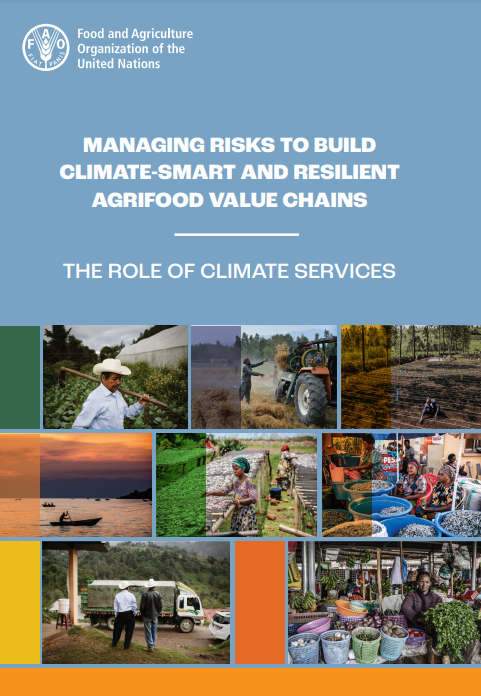
Managing risks to build climate-smart and resilient agrifood value chains – The role of climate services
2022
The report highlights the role of climate services in sustaining climate resilience as one of numerous potential investment options for enhancing climate risk management across agrifood value chains.
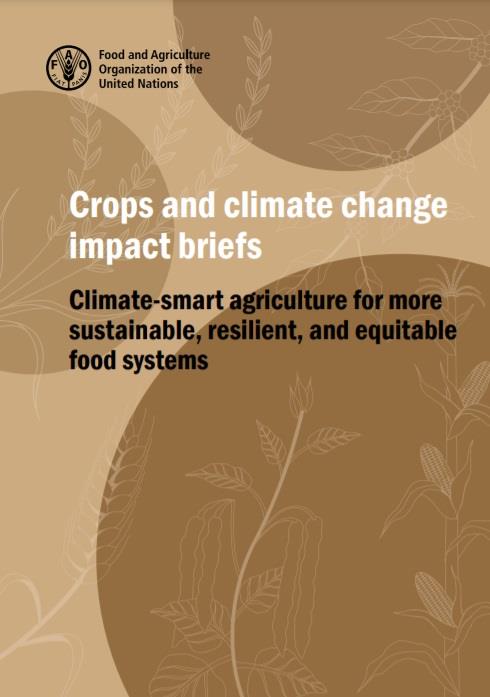
Crops and climate change impact briefs
2022
This series of technical briefs aims to provide a solid knowledge base for building or strengthening stakeholder capacities on climate-smart agriculture (CSA) and applying CSA practices to five crops that are critical to the global agri-food sector: coffee, cowpea, maize, rice and wheat.
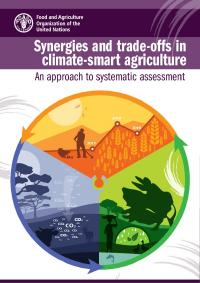
Synergies and trade-offs in climate-smart agriculture
2021
This publication analyses of the synergies and trade-offs that can occur within climate-smart agriculture (CSA), more specifically between its three pillars: (i) sustainably increasing productivity and incomes in agriculture, (ii) building resilience of and adapting food and agriculture systems to climate change, (iii) reducing/removing greenhouse gas emissions, where possible. The aim of this analysis is to develop a systematic characterization of possible synergies and trade-offs in CSA
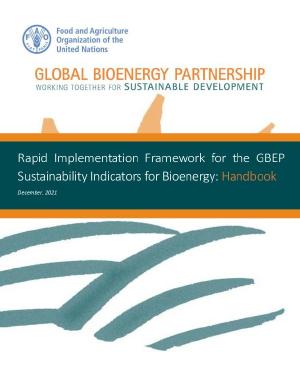
Rapid Implementation Framework for the GBEP Sustainability Indicators for Bioenergy: Handbook
2021
This Rapid Implementation Framework (RIF) aims to complement the Implementation Guide, by supporting and expediting the operationalization of selected working packages included in it. In particular, the RIF allows users to conduct an evidence-based prioritization of the GBEP indicators.
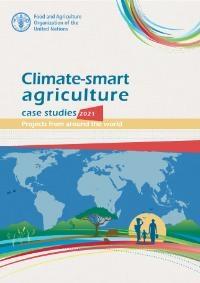
Climate-smart agriculture case studies 2021
2021
This publication describes climate-smart agriculture (CSA) case studies from around the world, showing how the approach is implemented to address challenges related to climate change and agriculture. The case studies operationalize the five action points for CSA implementation: expanding the evidence base for CSA, supporting enabling policy frameworks, strengthening national and local institutions, enhancing funding and financing options, and implementing CSA practices at field level.
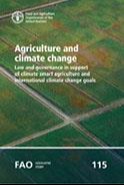
Agriculture and climate change
2021
This study aims to provide law-and policy-makers, researchers, as well as private and public sector partners, with a comprehensive overview of the legal and institutional issues to consider when working towards preparing their agriculture sectors for the challenges of climate change.
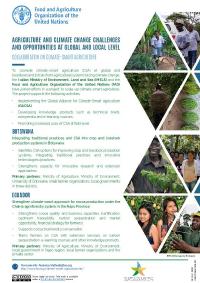
Agriculture and climate change challenges and opportunities at global and local level
2020
To promote climate-smart agriculture (CSA) at global and local level and to transform the agricultural system under climate change, the Italian Ministry of Environment, Land and Sea of Italy (IMELS) and the Food and Agriculture Organization of the United Nations (FAO) have joined their efforts in a project to scale-up climate-smart agriculture.
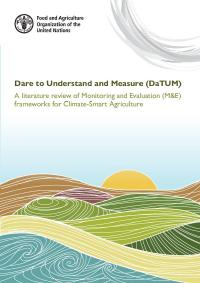
Dare to Understand and Measure (DaTUM). A literature review of monitoring and evaluation (M&E) frameworks for Climate-Smart Agriculture
2019
The main objective of this report is to review the monitoring and evaluation (M&E) frameworks, tools and guidance documents that are available for Climate-Smart Agriculture (CSA), and in particular for objective (“pillar”) two on adaptation and resilience.
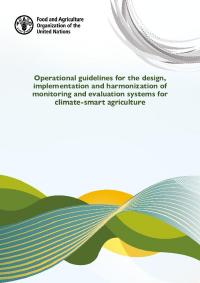
Operational guidelines for the design, implementation and harmonization of monitoring and evaluation systems for climate-smart agriculture
2019
These operational guidelines aim to address the core constraints and needs of FAO Member States on both the design and implementation of M&E systems that can simultaneously address CSA and sector reporting requirements for the 2030 Agenda, the Sendai Framework and the UNFCCC Paris Agreement.
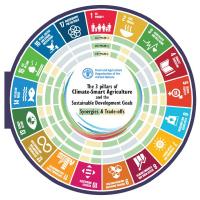
The 3 pillars of Climate-Smart Agriculture and the Sustainable Development Goals
2019
A flyer looking at the 5 implementation steps of Climate-Smart Agriculture and the Sustainable Development Goals, as well as the synergies & trade-offs.
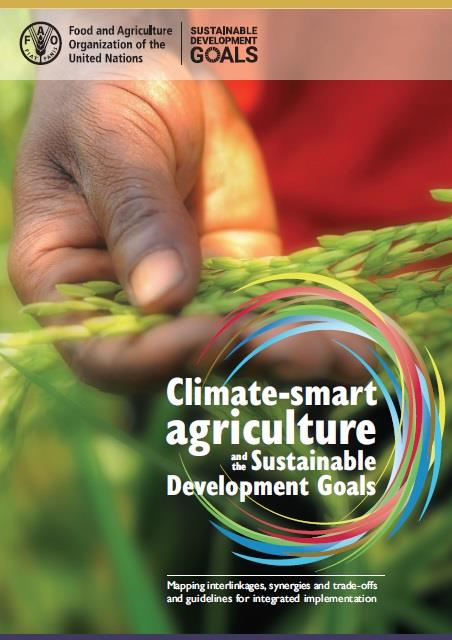
Climate-smart agriculture Sustainable Development Goals
2019
Mapping interlinkages, synergies and trade-offs and guidelines for integrated implementation. This paper represents a first step in defining specific ways in which climate-smart agriculture can support the achievement of the Sustainable Development Goals and nationally determined contribution objectives. Next steps may include: developing a methodology to assess context-specific synergies and trade-offs...
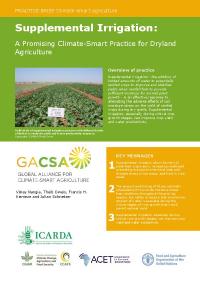
Supplemental Irrigation: A Promising Climate-Smart Practice for Dryland Agriculture
2018
Supplemental irrigation - the addition of limited amounts of water to essentially rainfed crops to improve and stabilize yields when rainfall fails to provide sufficient moisture for normal plant growth - is an effective response to alleviating the adverse effects of soil moisture stress on the yield of rainfed crops during dry spells. Supplemental irrigation, especially during critical crop growth stages, can improve crop yield and water productivity.
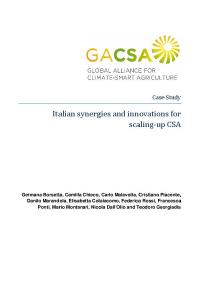
Italian synergies and innovations for scaling-up CSA
2018
Since last decades, climate change has become one of the major leading driver of global and national challenges for the protection of the environment and the human health, putting massive pressure on food production and in particular on food security. Developing efficient adaptation and mitigation strategies at the national and local level is essential to building resilience to climate change throughout the food system.
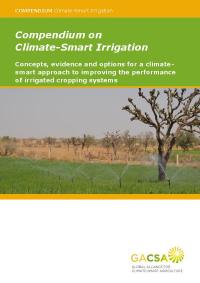
Compendium on Climate-Smart Irrigation
2018
Irrigation plays an important role in global food security, helping to produce 40 percent of crops worldwide on just 20 percent of the world’s cultivated area. It is also the major single water user globally, accounting for about 70 percent of water abstracted from surface and groundwater resources, and faces a number of challenges, mainly linked to its dependence on water as a key resource.
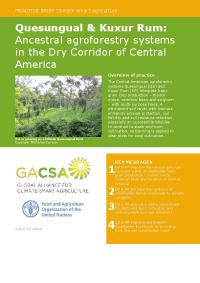
Quesungual & Kuxur Rum: Ancestral agroforestry systems in the Dry Corridor of Central America
2018
The Central American agroforestry systems Quesungual (QS) and Kuxur Rum (KR) integrate basic grain crop production – mainly maize, common bean and sorghum – with multi-purpose trees. A permanent soil cover with biomass enhances erosion protection, soil fertility and soil moisture retention, especially on susceptible hillsides. In contrast to slash-and-burn cultivation, no burning is applied to clear plots for crop cultivation.
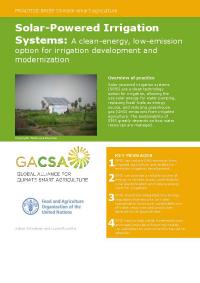
GACSA PRACTICE BRIEF Climate-smart agriculture. Solar-Powered Irrigation Systems: A clean-energy, low-emission option for irrigation development and modernization
2017
Solar-powered irrigation systems (SPIS) are a clean technology option for irrigation, allowing the use solar energy for water pumping, replacing fossil fuels as energy source, and reducing greenhouse gas (GHG) emissions from irrigated agriculture. The sustainability of SPIS greatly depends on how water resources are managed.
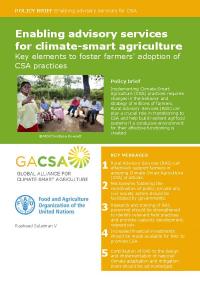
GACSA: Enabling advisory services for climate-smart agriculture
2017
Implementing Climate-Smart Agriculture (CSA) practices requires changes in the behavior and strategy of millions of farmers. Rural Advisory Services (RAS) can play a crucial role in transitioning to CSA and help build resilient agrifood systems if a conducive environment for their effective functioning is created
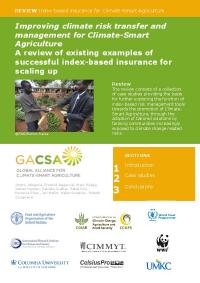
GACSA. REVIEW Index-based insurance for Climate-Smart Agriculture
2017
The review consists of a collection of case studies providing the basis for further exploring the function of index-based risk management tools towards the promotion of ClimateSmart Agriculture, through the adoption of tailored solutions by farming communities increasingly exposed to climate change related risks.
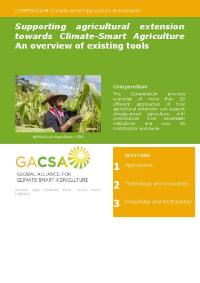
COMPENDIUM Climate-smart agriculture & extension
2016
The Compendium provides examples of more than 20 different approaches of how agricultural extension can support climate-smart agriculture, with contributions from seventeen institutions and over 30 contributors worldwide.
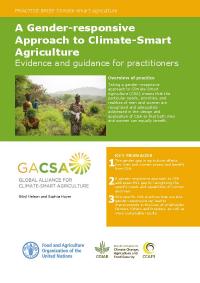
A Gender-responsive Approach to Climate-Smart Agriculture. Evidence and guidance for practitioners
2016
Taking a gender-responsive approach to Climate-Smart Agriculture (CSA) means that the particular needs, priorities, and realities of men and women are recognized and adequately addressed in the design and application of CSA so that both men and women can equally benefit.
